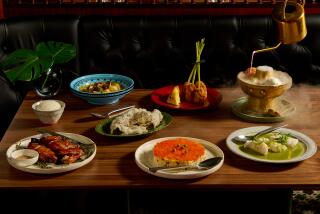‘Carrion in Custard,’ Redoubtable Durian Is Loved and Hated in Southeast Asia
- Share via
SINGAPORE — Long banned from most hotels, hospitals and commercial airliners in Southeast Asia, the redoubtable durian is now barred from Singapore’s new subway, the Mass Rapid Transport system.
The fabled, smelly fruit is back in season and signs at each subway station warn: “No durians are allowed on the MRT.”
Eating and drinking on trains has been a no-no since the subway opened in November, but shoppers were allowed to carry food.
So pungent is the durian, however, that extra precautions are deemed necessary to keep it at bay. Violators face the equivalent of a $250 fine.
Lingering Odor
“We all know that durians leave a lingering odor long after they are taken away, especially in an air-conditioned place, and the trains are air conditioned,” an MRT spokesman said. “The smell is even offensive to those who love the fruit.
“They might like eating the fruit, but I don’t think they like the smell too much.”
Calling the spiky green fruit smelly does it an understatement.
It stinks.
Most descriptions of the durian’s smell are unprintable, but one that is printable describes the fruit this way: “Rich brimstone musk, whispering of depravity and month-old eggs. Durian is to fruit what Limburger is to cheese and pornography is to literature.”
‘Carrion in Custard’
A British governor of Singapore in colonial days likened it to “carrion in custard.”
The fragrance allows no indifference: You love it or you leave the room.
The telltale stench permeates sections of Singapore, Malaysia, Thailand, Indonesia and the Philippines now that the main season for the durian has started. Durians ripen twice a year, in December and January and in June and July.
The powerful aroma is the perfume of prosperity for growers and others in the trade. Prices vary widely according to freshness, weight, shape and where they are grown, a market that seems as delicately balanced as Wall Street.
Three average durians sold for the equivalent of $5 as the season opened. Individual prime quality fruits fetched more than five times as much.
Thai Durians Tops
Thailand is the biggest commercial grower, and old hands usually rate Thai durians as tops in consistency and flavor. The most malodorous seem to be grown in the Philippines.
Malaysian devotees regard it as passion fruit capable of stirring deep emotions, and there are tales of patient Indonesians waiting days for durians to fall from trees, only to have to battle Sumatran tigers for possession of the fruit.
Folklore warns that durian is “heady” and should not be eaten with alcohol. Those who do so are said to risk exploding.
Related botanically to hibiscus, hollyhock, cotton and kapok, the durian is native to Malaysia and has been cultivated for centuries. Unlike the shorter Thai plantation version, trees in Malaysia and elsewhere are too lofty to harvest and the fruit crashes to the ground when it is ripe.
Changng Flavor
Fermentation that starts the moment it drops can change the flavor perceptibly within hours. The fruit spoils within a week, and few will eat durian more than three days after they fall.
No junk food, the much-loved, much-hated durian is high in protein, carbohydrates and vitamins B and C. Experts say it thrives in soil with a high sulfur content, which doubtless contributes to the pungent odor.
Durians vary widely in size but usually are 8 inches long and 6 1/2 inches wide and weigh about 6 1/2 pounds. The outer rind bristles with tough thorns or “duri.”
More to Read
Eat your way across L.A.
Get our weekly Tasting Notes newsletter for reviews, news and more.
You may occasionally receive promotional content from the Los Angeles Times.










